THE LOCK
The iron construction for transferring ships was one of the most modern technological constructions at the end of the 19th century
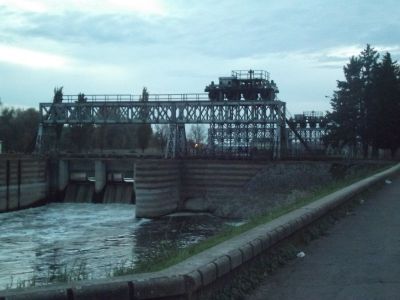
Hydroelectric station next to the lock produced electricity needed for the functioning of lock paddles – this was the first electric boat lift of iron construction, but it was among the most modern and hugest constructions of its kind of that age in the whole world. On the top of the lock there was a smaller steam-engine, which enabled the opening and closure of the flood gate. On the ribbon cutting ceremony, according to later accounts, there was even a delegation from Japan, but German, French and British experts came to have a look at the great wonder, too.
The dimensions of the flood gates were designed in a way that even the biggest steamboats could pass through them, however in those times passenger ship traffic was quite busy, too: twice a week, a passenger ship sailed from Szeged to Zimony and docked in Becej, too, but after the I WW there was a Belgrade line and connection to Novi Becej, as well – following the II WW, ship Jelena was almost the only connection between Backa and Banat. The building of fluvial captaincy built in 1877 was ruined in the 70's of the 20th century during works, which had the aim to strengthen the dam.
Sometime the most modern lock of the world, today does not function anymore – it is an exceptionally important industrial monument and touristic attraction. Second phase of the reconstruction work at the old boat lift`s turbine station has begun in 2009 – with the support of the Becej local government and the Waters of Vojvodina public firm – the work is about to be finished, and according to earlier plans there will be a permanent exhibition in the building starting next year. While reconstruction work was going on, unfortunately, one of the exhibits was stolen: an electric motor of the turbine station that is no longer in use – the art treasure is worthless for the thieves, but it is of great value for the technicians.
Numerous old postcards recorded the lock in Becej, no wonder: when it was built, with its perfect structure it was a technological miracle – among the very best in the world.
Until 1900 the waterway sometime called Franz waterway (Ferenc-csatorna) that connected the Danube and the Tisza fell into the Tisza at Backo Gradiste. Since the water level of the river was every year so high that it flooded the greater part of the village, the firth was replaced to Becej – work ordered by Joseph Franz was completed in 1899. The channel between Backo Gradiste and Becej was 8 km long, and it was built according to the plans of the 24 years old Hainz Albert, who was technological director of the watercourse.
The lock called István Türr was built at the firth of the sometime Franz-waterway connecting the Danube and the Tisza at the Tisza river ending of the waterway. The watercourse was taken over from the Hungarian state by István Türr for a period of 75 years, the water lift was built according to his charge and the plans of Heinz Albert, in the period of 1895–1900. According to some sources, Gustave Eiffel, the designer of the Eiffel-tower and the Western Railway Station in Budapest took part in the planning of the water-regulator, too.
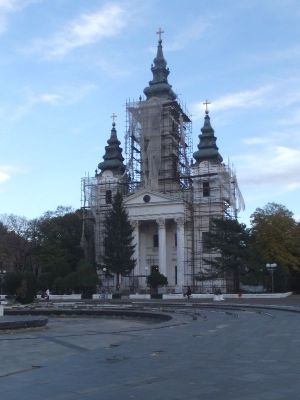
THE ORTHODOX CHURCH
The Orthodox church is named after the martyr Saint George. It was built in late classicist style. The three towers which symbolize the Holy Trinity were built in baroque style. Construction work for building the church began in 1851. Andrija Schmaus was the chief architect, his assistant was Mita Somborski. Construction work ended in 1858. The facility has one nave with a five-sided apse and a choir on the side.
In the foreground of the main entrance, where one can get by a stairway, four tall pillars hold a triangular tympan. The two copper coated towers on the side were built in baroque style. The church is a classic example of mixing baroque and eclectic styles.
The first Orthodox church in Becej was ruined during the period of unrest in 1848.
The altar painting of the Saint George Church is made up of 63 icons in baroque style. It was constructed by a famous artist from Vienna, Küstner in 1868. Gilding was done by Járai, an artist from Vienna, too. Paintings were created by the famous painter, Uroš Predić in the period of 1889-1893. It took two years to construct the altar painting. It is an interesting detail that before constructing the altar painting, the artist exhibited the paintings. That was the first art exhibition in Becej. The paintings were restored by the artist himself in 1930 and 1931.
The church was restored again in 1972, and this time a part of the tower construction was replaced.
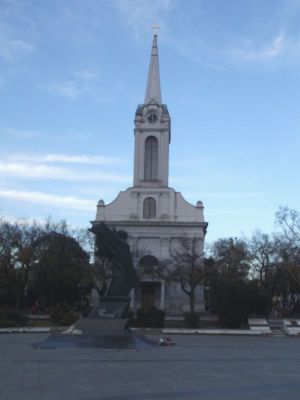
THE CATHOLIC CHURCH
The first Catholic church with cob walls and sedge roof was built in 1763, and it was ruined in 1786. In 1830, a new church was built at that same place, which had the Blessed Virgin Mary as its patron saint. The church was built in early classicist style at first, but later different styles of architecture were combined. The surface of the church is 48,7 x 17 m, and its today form was created in 1887. In 1923, new elements were added to the tower. Vitrage was made by Ede Kratzman. The inside of the church is decorated with baroque style ornaments.
The main altar painting representing the Assumption of Blessed Virgin Mary was painted by the famous painter, Mór Than.
THE TISZA RIVER
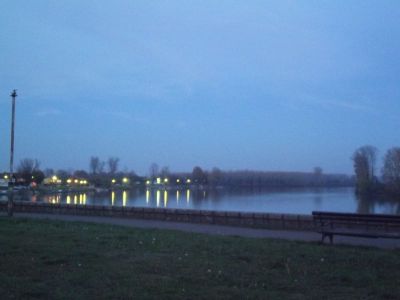
4% of overall surface of Becej municipality is covered by waterways. Among them the Tisza river is the most significant, which makes 23 km long the eastern border of the municipality. This length makes 14,02% of the total length of the river in Vojvodina.
On the territory of Becej municipality, in the Tisza river there are 22 sorts of fish belonging to 7 different families of fish. The most numerous is the family of carps (14 sorts) and basses (3 sorts). From the point of view of sport fishing, one has to mention the families of sheatfish and pike, both are represented by one species. Another creature contributes to the abundancy of the river: mayflies (insects belonging to the ancient group of insects called Ephemeroptera – Greek word, literally meaning "lasting a day") reappeared after many years in 2000, following a great flood, and since then, every year in the second half of June, they can be seen on the river.
The Tisza river is the biggest left-side feeder of the Danube. It flows through the Pannonian basin. Its spring is in Ukraine and it flows through Romania, Hungary and Serbia. It flows into the Danube at Stari Slankamen. The Tisza river comes from the meeting of the Black and White Tisza. Its length is 1358 km, its watershed surface is 157 186 m2. In Vojvodina the Tisza river separates Backa (on the right side) from Banat (on the left side).
Its largest tributary streams are the Begej, the Bodrog, the Aranka, the Maros, the Szamos and the Sajó. The Tisza is navigable 532 km long. The Backa waterway connects the Tisza with the Danube, while the Begej waterway connects it with the Tamis. Larger towns on the Tisza riverside are: Tokaj, Szolnok, Csongrád, Szeged, Senta and Becej. The Tisza, while flowing through the mountains, is a clean, rapid river. Since there are no lakes in the Carpathian Mountains, the water level of the river is quite variable, and there are three typically flood risky periods during the year. When high water level of the Tisza coincides with high level of the Danube, the river heaves and causes huge floods. This kind of flood ruined the whole town of Szeged in the spring of 1879.
Thanks to the river-regulating works between 1846 and 1880 ordered by Hungarian authorities, the length of the Tisza river was reduced by 450 km. The defense system against flood built by then is considered to be the largest one in Europe. Today a 3680 km long waterway system regulates the water level of the Tisza. During the 1980`s with the aim of flood defense an artificial lake was built on the Tisza, which became a holiday attraction among Hungarians, almost as popular as the Lake Balaton. The Tisza is navigable almost in its whole length. It has been opened for international shipping recently, since earlier Hungary divided its rivers into state and international rivers and the state allowed foreign ships' transit on the rivers in the country according to this division. After getting the EU-membership this division was cancelled, and the Tisza has become navigable for everyone.
Navigation often depends on weather and natural conditions. In case of high water level or drought the Tisza is not suitable for shipping.
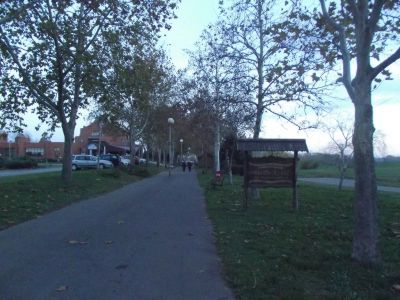
GREEN PROMENADE
The walkway called the Green Promenade is a continuation of the Zöldfás (Greenwoods) street towards the Tisza, in front of the Fehér Hajó (White Ship) Hotel, and it was opened on the International Day of the Earth, this way reminding on the need to promote the idea of environment protection. From the Green Promenade there is a view on the lower park and the sometime race-track, where a spa-touristic complex is planned to be built soon.
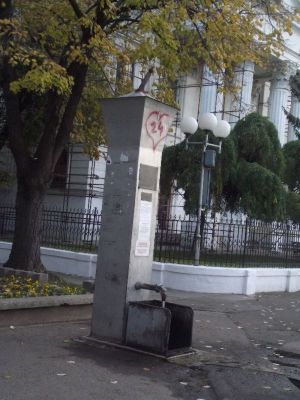
YELLOW WATER WELLS
One of Becej's trademark is the artesian well with yellow water, or mineral water belonging to the sodium hydrocarbonate hypotherms.
The oldest well of that kind is at the main square of Becej. It was dug according to the charge of Károly Sós in 1904. Later on, Károly Sós ordered to build a couple of wells in different parts of the town, one at his own property, too. This way he laid the grounds for the spa in Becej, the today hydrotherapic establishment. The tradition of digging yellow water wells was continued by Ferenc Reperger, who lead the digging of two more wells in the 30`s.
Yellow water wells have become trademarks and touristic attractions of the town, since according to the legend, if someone drinks this water from the well, he/she will stay in Becej forever.

